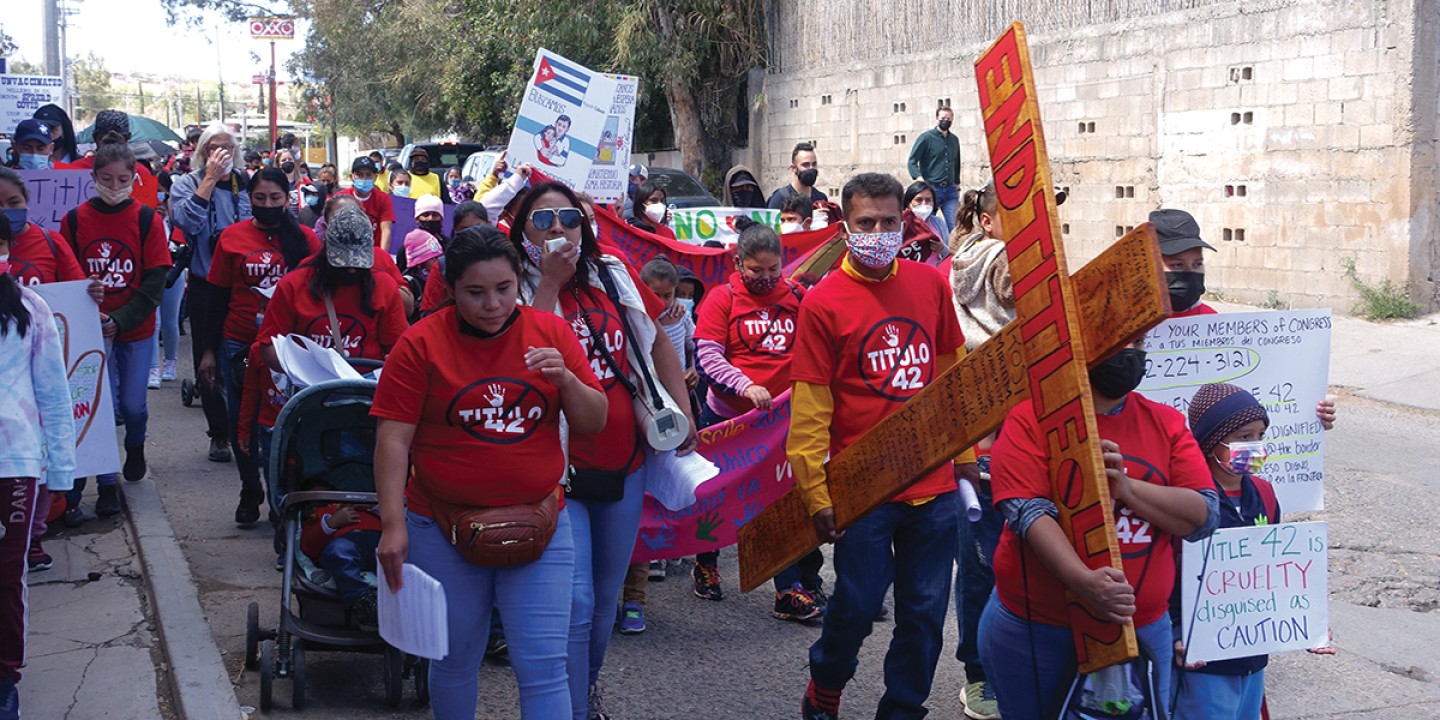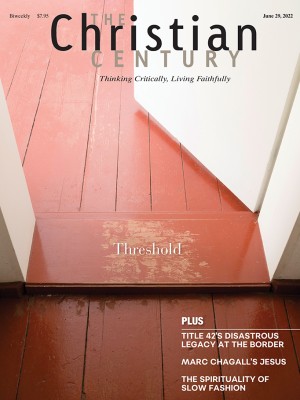Title 42’s disastrous—and illegal—legacy at the southern border
The Biden administration has reversed Trump’s rhetoric around migrants but not all of his policies.

In March 2020 the scope and seriousness of the global coronavirus pandemic were just becoming evident around the globe. It was then that an obscure section of a public health policy from eight decades earlier was invoked by the Trump administration to slam the gates shut on the southern border to all migrants and asylum seekers, on the grounds that they might carry COVID-19 into the United States.
Title 42—more precisely, Section 265 of Title 42 of the US Code, enacted as part of the Public Health Service Act of 1944—permits the exclusion from the United States of any noncitizen who poses a “serious danger” of spreading a “quarantinable communicable disease.” Trump adviser Stephen Miller had tried twice before to use this forgotten regulation as a reason to close the border—first in 2018, for general health reasons, and again in 2019, citing a mumps outbreak. Both attempts failed.
Read our latest issue or browse back issues.
Then the pretext Miller needed arrived with a bang, and his boss agreed to pressure the Centers for Disease Control and Prevention to declare a health emergency at the border. CDC leaders balked, finding no basis for such a measure when infection rates were higher in the United States than in Mexico. But politics prevailed over science. From March 20, 2020, nearly everyone seeking to enter the US from the south was turned away.
When the Biden administration took office in January 2021, White House rhetoric on immigration shifted. Several policy changes were put in place right away, but to the dismay of would-be asylum seekers and their allies, Title 42 was not revoked, and it remains in place today. There have been 1.7 million Title 42 expulsions at the border, more than half of them during Biden’s time in office. Nearly all were fleeing from violence in southern Mexico or Central America. Some arrivals from Cuba, Venezuela, and other more distant countries have been allowed across—very few in the Trump era, larger numbers under Biden—because Mexican officials will not allow them to wait on that side of the border.
The public health rationale, threadbare from the start, has become a cruel joke. Vaccination rates are similar in the two countries, while infection rates have remained higher on the US side. Meanwhile, migrants refused entry fall victim to violence and extortion in Mexican border towns, where landlords charge exorbitant rents for substandard housing and drug cartels hold kidnapped children for ransom. Church groups and nonprofit organizations have stepped up to provide for migrants’ basic needs, while both US and Mexican governments look away. But the food pantries and meal programs and shelters are strained to their limits.
Under a great deal of public pressure, the Biden administration announced in March that it would no longer enforce Title 42 after May 23. Asylum seekers and their allies expressed joy—but also feared that politics would again trump science and the border would remain closed. Their fears were fulfilled a few days later, when a bipartisan group of 11 senators introduced a bill to extend the enforcement of Title 42, and the attorneys general of 24 states—all of them Republicans—joined in a lawsuit that would bar its suspension.
The Senate bill never reached the floor, but the legal challenge was taken up by a federal judge in Louisiana. In April Judge Robert Summerhays issued a temporary order blocking the Biden administration from preparing for a May 23 end date, and on May 20 this was followed by an injunction extending Title 42 enforcement until the state lawsuits are heard. The effect, say most observers, is that asylum seekers will continue to be turned away until at least the end of the year.
The rationale for further delay, according to the attorneys general and the Senate bill’s author, Kyrsten Sinema of Arizona, is the need to prepare adequately for reopened borders. But this was immediately countered by the Kino Border Initiative, a Catholic ministry and advocacy group that assists migrants on both sides of the border, and its partners in humanitarian aid for migrants. In a joint press release, KBI and the Florence Immigrant and Refugee Rights Project observed that even while “the United States government has failed in its moral and legal requirements” to asylum seekers, “local non-profits have worked diligently to respond to migrants’ needs on both sides of the border” and “continue to be ready and able to welcome asylum seekers when Title 42 ends.” The real motivation behind the Senate bill and the states’ lawsuit, unfortunately, has more to do with politics than logistics. Several of the sponsors of the bill and parties to the lawsuit face elections this year, and none wants to appear soft on immigration.
It is important to distinguish between two different groups turned back at the border. Migrants seeking to enter the United States to rejoin their families or seek employment are subject to US immigration laws, under criteria and quotas set by Congress and the administration. Their exclusion has created hardship for families and employers alike, and the continuation of Title 42 when infection rates in migrants’ home countries are lower than they are here is inconsistent with long-standing US laws and policies. But this exclusion does not flout international law.
Turning away those fleeing violence at home, on the other hand, is a flagrant violation of international agreements that the United States has signed. Under the provisions of the United Nations Charter and its covenants on refugee rights, anyone in imminent danger of persecution or torture at home, whether from war or cartel violence or government-sponsored repression, is entitled to enter another country and apply there for asylum. The United States and all other UN members are required to admit refugees temporarily, then determine whether they face a “credible fear” of harm if they return home.
Just a few days before the administration’s surprise announcement in March, I participated in an unusual Lenten procession in Nogales, in Sonora, Mexico. With friends from my Tucson church and a few other US supporters, I joined a procession of more than 150 refugees one Monday morning. Following a large wooden cross, we set out from the offices of KBI and walked together through the narrow streets of Nogales to a central square. KBI staff members told me that the procession had been planned by a group of asylum seekers. They had selected the route and marked the 14 traditional Stations of the Cross along the way.
At each station we paused for a scripture reading, a prayer, and a brief meditation from one of the asylum seekers. At the station remembering Simon of Cyrene’s assistance in carrying Jesus’s cross, the speaker cited the assistance that churches and volunteers provide to migrants. Before moving on each time we sang a popular Mexican penitential song, “Perdona a tu pueblo, Señor” (“Forgive your people, Lord”).
On the processional cross was the demand, “End Title 42!” Meditations on the events of Jesus’ last day drew parallels between the Savior’s suffering and that of the victims of repression and violence today. At the first station, “Jesus is sentenced to death,” we were reminded that “many migrants experience death sentences outside their own homes. Sometimes the threats take the form of words, sometimes they take the form of shoot-outs.” At the second station, “Jesus carries the cross,” the speaker observed that “people who migrate looking for safety carry many crosses: the pain and sadness of what they wanted or had envisioned for their family, losing the safety of the life they once knew.”
“Two years of Title 42, two years of injustice, two years of expulsion, two years of racism, two years of discrimination, two years of being ignored . . . not one more day!”
“From north to south, from east to west: migrants together, whatever the cost!”
These were some of the slogans shouted by the pilgrims in Nogales as they walked. The readings, reflections, and chants were in Spanish, and so were the signs, except for a few hand-lettered in English for visitors and photographers: “Call your members of Congress! End Title 42!” “Title 42 is cruelty disguised as caution.”
KBI was created in 2009 by six Catholic organizations in the United States and in Mexico, among them two Jesuit provinces (California and Mexico) and two dioceses (Tucson, Arizona, and Nogales, Sonora). Its activities include humanitarian assistance to migrants and refugees, community education on both sides of the border, and collaborative advocacy for immigration policy reform. Three members of the Jesuit order are among the 27 staff members today.
Nearly two-thirds of the migrants who receive assistance from KBI, executive director Joanna Williams told me, have come from southern regions of Mexico. Another one-quarter are Honduran, and small numbers have come from other countries. New arrivals are welcomed each day and given information about the asylum application process. KBI’s dining hall, el comedor, served nearly 200,000 meals to migrants last year, and Nazareth House offers temporary shelter to women and children. Initially funded by the founding Catholic organizations, KBI now relies primarily on individual donors from both sides of the border, Williams told me—Catholic, Protestant, and unaffiliated.
At Casa Alitas, a Tucson shelter for asylum seekers where members of my church volunteer, we used to see a dozen or fewer arrivals from Arizona border stations per day, all of them having come from outside Central America. Numbers have increased rapidly during the Biden administration: on one recent day we welcomed 240 arrivals. Most would stay just a night or two before meeting sponsors elsewhere in the United States. Backlogs in immigration courts mean years of uncertainty and then, for many, deportation.
The Biden administration has proposed several measures to ease the backlog, including expansion of the ranks of asylum officers and wider discretion to grant or deny “credible fear” claims without the formality of a court hearing. These measures will take months to implement, and whether they will improve timeliness and fairness is an open question.
In the meantime, for many migrants and their supporters, it is painful to watch the United States make it easy for Ukrainians who have made their circuitous way through Mexico to the United States to enter. The welcome being extended by immigration officials and many churches to these new refugees, while Title 42 continues to block entry for nearer neighbors, gives unfortunate confirmation of the allegations on the signs in Nogales: current US border policies are not only unjust and illegal but also racist.
At the 14th station of the cross in our Nogales procession, marking Jesus’ interment in the tomb, the meditation prepared by refugees turned back at the border offered this reflection:
People in power tried to bury the movement that Jesus had started—a movement for inclusion, freedom, and justice. But they failed; he was resurrected on the third day. Injustice cannot be hidden or buried. We ask President Biden’s administration in the United States and President López Obrador’s administration in Mexico to stop ignoring the danger, racism, and suffering many migrants are enduring when they request asylum at the border. We demand that you turn around and face reality—and that you do not hide or bury it.
Let the people say, “Amen!” And say it loudly enough to be heard in Washington.
A version of this article appears in the print edition under the title “Turned away.”






